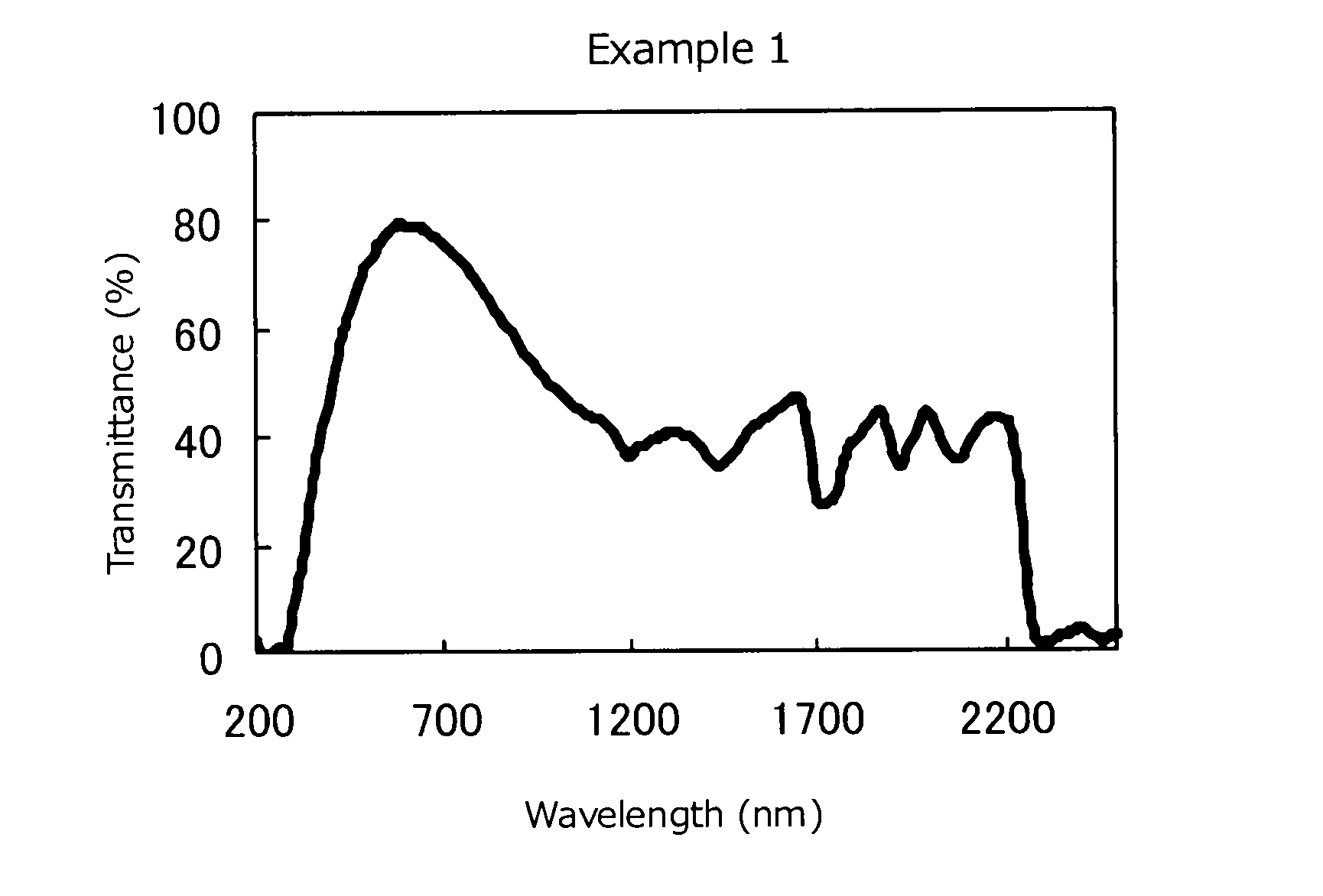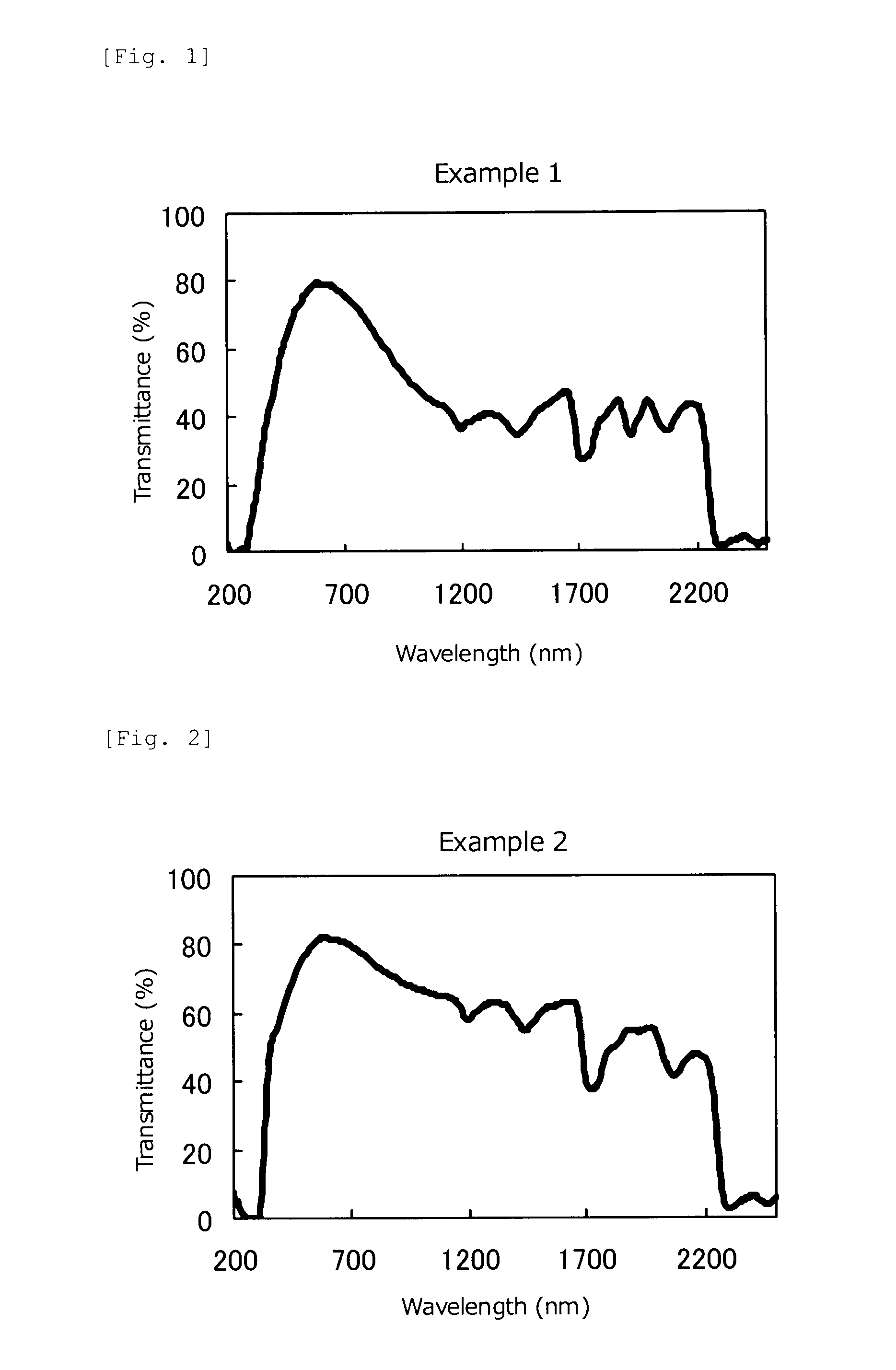Film and intermediate film for laminated glass composed of the same
a technology of laminated glass and intermediate films, applied in the field of laminated glass film and intermediate films composed of the same, can solve the problems of not being able to shield, haze becomes worse, and actual use is subject to some limitations, and achieves excellent transparency, good adhesion to glass, and electromagnetic wave permeability. good, good adhesion
- Summary
- Abstract
- Description
- Claims
- Application Information
AI Technical Summary
Benefits of technology
Problems solved by technology
Method used
Image
Examples
example 1
(1) [Fabrication of Film]
[0081]A polyvinyl butyral resin (Mowital B68 / 1SF produced by Kuraray Specialities Europe (KSE)) was press-molded at 140° C. for 5 minutes with a pressing machine, and thereby a film having a thickness of 1 mm was fabricated. The resulting film was immersed for 300 seconds in 1 L of a methanol / water mixed solvent (weight ratio: 3 / 1) at 25° C. in which 50 g / L of copper nitrate was dissolved, and then was immersed for 300 seconds, while applying ultrasonic waves, in 1 L of a methanol / water mixed solvent (weight ratio: 3 / 1) at 25° C. in which 20 g / L of sodium sulfide was dissolved. Further, the film was fully washed with a methanol / water mixed solvent (weight ratio: 3 / 1) and was dried, and thereby a copper sulfide combined film was obtained.
(2) [Evaluation Result]
[0082]The results of performance evaluation of the resulting film are shown in Table 1 and FIG. 1.
example 2
[0083]A polyvinyl butyral resin (Mowital B60H produced by KSE) was shaped and further pelletized with a twin-screw molding machine, and thereby pellets with a size of an approximately 1 cm cube were fabricated. Ten grams of the pellets were immersed for 30 seconds in 1 L of an n-propanol / water mixed solvent (weight ratio: 1 / 1) at 25° C. in which 100 g / L of copper nitrate was dissolved, and the pellets were filtered off, followed by immersing the pellets for 30 seconds, while applying ultrasonic waves, in 1 L of an n-propanol / water mixed solvent (weight ratio: 1 / 1) at 25° C. in which 20 g / L of sodium sulfide was dissolved. After that, the pellets were fully washed with an n-propanol / water mixed solvent (weight ratio: 1 / 1) and were dried, and thereby pellets of a copper sulfide combined polyvinyl butyral resin were fabricated. Further, 6 g of the pellets mentioned above, 34 g of a polyvinyl butyral resin (Mowital B68 / 1SF produced by KSE), and 15.2 g of triethylene glycol-di-2-ethylhex...
example 3
[0084]A polyethylene vinyl acetate copolymer resin (EVAFLEX EV45LX produced by Du Pont-Mitsui Polychemicals Co., Ltd.) was press-molded at 160° C. for 5 minutes with a pressing machine, and thereby a film having a thickness of 0.76 mm was fabricated. The resulting film was immersed for 30 seconds in 1 L of a methanol / THF mixed solvent (weight ratio: 1 / 1) at 25° C. in which 50 g / L of copper nitrate was dissolved, and then was immersed for 30 seconds, while applying ultrasonic waves, in 1 L of a methanol / THF mixed solvent (weight ratio: 1 / 1) at 25° C. in which 20 g / L of sodium sulfide was dissolved. Further, the film was fully washed with a methanol / THF mixed solvent (weight ratio: 1 / 1) and was dried, and thereby a copper sulfide combined film was obtained. The results of performance evaluation of the resulting film are shown in Table 1 and FIG. 3.
PUM
| Property | Measurement | Unit |
|---|---|---|
| Percent by mass | aaaaa | aaaaa |
| Percent by mass | aaaaa | aaaaa |
| Percent by mass | aaaaa | aaaaa |
Abstract
Description
Claims
Application Information
 Login to View More
Login to View More - R&D
- Intellectual Property
- Life Sciences
- Materials
- Tech Scout
- Unparalleled Data Quality
- Higher Quality Content
- 60% Fewer Hallucinations
Browse by: Latest US Patents, China's latest patents, Technical Efficacy Thesaurus, Application Domain, Technology Topic, Popular Technical Reports.
© 2025 PatSnap. All rights reserved.Legal|Privacy policy|Modern Slavery Act Transparency Statement|Sitemap|About US| Contact US: help@patsnap.com



